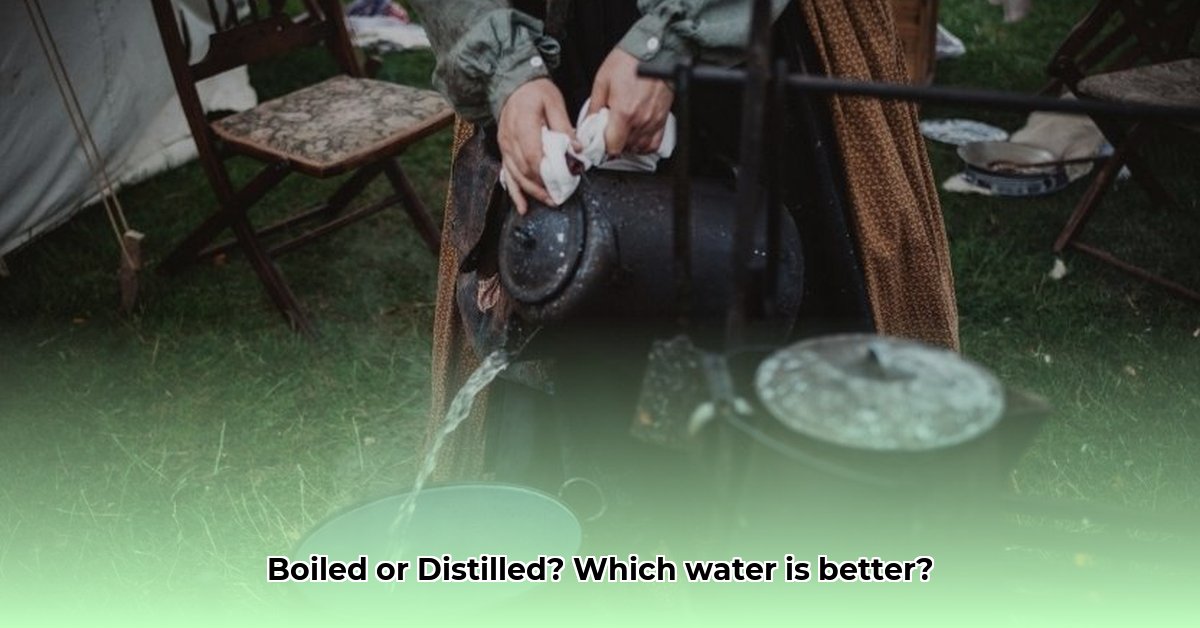Understanding Boiled vs. Distilled Water
Many people believe boiled and distilled water are the same, but this is a misconception. While both processes involve heat, they achieve different levels of purification and have distinct applications. This guide clarifies the differences, exploring the science behind each method, their respective benefits and drawbacks, and how to choose the best option for your needs.
Comparing Boiling and Distillation
| Feature | Boiled Water | Distilled Water |
|---|---|---|
| Process | Heating water to its boiling point (100°C/212°F at sea level) | Boiling water, collecting the steam, and condensing it back into liquid water |
| Impurities Removed | Primarily disease-causing microorganisms (bacteria, viruses, protozoa) | Most impurities, including minerals, chemicals, and microorganisms |
| Mineral Content | Retains natural minerals | Minerals are removed |
| Taste | Largely unchanged; may taste metallic if source water is hard | Flat or bland due to lack of minerals |
| Uses | Emergency disinfection, general cooking, hot beverages | Appliances (humidifiers, steam irons), car batteries, laboratory work, diluting concentrated drinks |
| Cost | Very low (requires a heat source and pot) | Moderate (distiller required), low per-gallon cost over time |
| Environmental Impact | Minimal | Moderate (higher energy consumption than boiling) |
Boiling Water: A Quick Disinfectant
Boiling is a simple and effective way to kill most harmful microorganisms in water. This makes it ideal for emergency situations or when traveling in areas with questionable water quality.
How to Boil Water Safely:
- Fill a pot with water: Use a clean pot.
- Heat to a rolling boil: Vigorous bubbling indicates a rolling boil.
- Maintain the boil: Boil for 1 minute at sea level; 3 minutes at higher altitudes (above 6,500 feet). This compensates for the lower boiling point at higher altitudes.
- Cool and store: Allow to cool naturally before storing in a clean, sealed container.
Limitations of Boiling:
Boiling does not remove sediment, chemicals, or dissolved minerals. In fact, some impurities may become more concentrated as water evaporates.
Distillation: Achieving High Purity
Distillation purifies water by separating it from its impurities through phase changes. The process involves boiling the water, capturing the steam, and condensing it back into liquid water. This leaves behind most contaminants, resulting in highly purified water.
The Distillation Process:
- Heating and Boiling: Water is heated and brought to a boil.
- Evaporation: Water converts to steam, leaving behind impurities.
- Condensation: Steam is cooled and condenses back into purified liquid water.
- Optional Carbon Filtration: Some distillers include a carbon filter to remove volatile organic compounds (VOCs).
Is Distilled Water Safe to Drink?
Distilled water is safe to drink, but because it lacks minerals, exclusive, long-term consumption could potentially lead to mineral deficiencies. This is more likely if you consume distilled water exclusively and less probable if your diet is rich in mineral sources. If concerned, consider these options:
- Remineralization: Add mineral drops or a pinch of mineral-rich sea salt to your distilled water.
- Dietary Adjustments: Ensure a balanced diet rich in essential minerals.
- Consult a Healthcare Professional: Discuss your water intake and mineral levels with your doctor, especially if you have any underlying health conditions.
Choosing the Right Method
- Emergency Disinfection: Boiling is the quickest and most accessible method.
- High Purity Water: Distillation is best for applications requiring mineral-free water, such as appliances, car batteries, and some medical uses.
- Everyday Drinking: While both are safe in moderation, neither is ideal for long-term exclusive consumption without addressing mineral content. Consider other purification methods like reverse osmosis or filtration for regular drinking water. These methods strike a balance between purity and mineral retention.
Other Purification Methods
- Reverse Osmosis: Forces water through a semipermeable membrane, removing a wide range of contaminants while retaining some beneficial minerals.
- Filtration: Uses various filter media (activated carbon, ceramic, etc.) to trap impurities, with the level of purification depending on the specific filter type.
Cost and Environmental Considerations
- Boiling: Most cost-effective and energy-efficient method.
- Distillation: Higher initial investment for a distiller but provides high-purity water at a low per-gallon cost over time. Uses more energy than boiling.
Frequently Asked Questions (FAQ)
- Is boiled water the same as distilled water? No. Boiling primarily kills microorganisms, while distillation removes a much broader range of impurities, including minerals.
- Can I drink distilled water every day? Yes, in moderation. However, long-term exclusive consumption of distilled water is not generally recommended due to potential mineral depletion.
This information is intended for general knowledge and informational purposes only, and does not constitute medical advice. For personalized advice, consult with a qualified healthcare professional. Always consider local regulations and guidelines concerning water safety and purification.
- Glass Lunch Box Containers Offer Healthy, Leak-Proof Meal Prep - December 21, 2025
- Glass Bento Boxes Offer a Healthy, Eco-Friendly Lunch Solution - December 20, 2025
- Glass Bento Containers Make Packing Lunch Easier and Healthier - December 19, 2025










